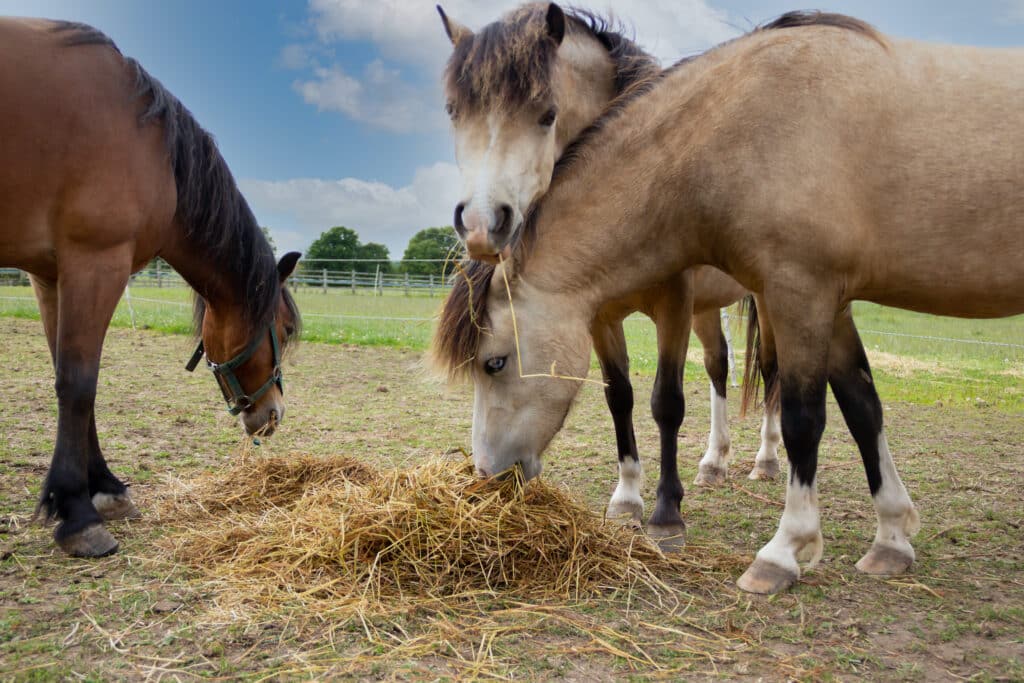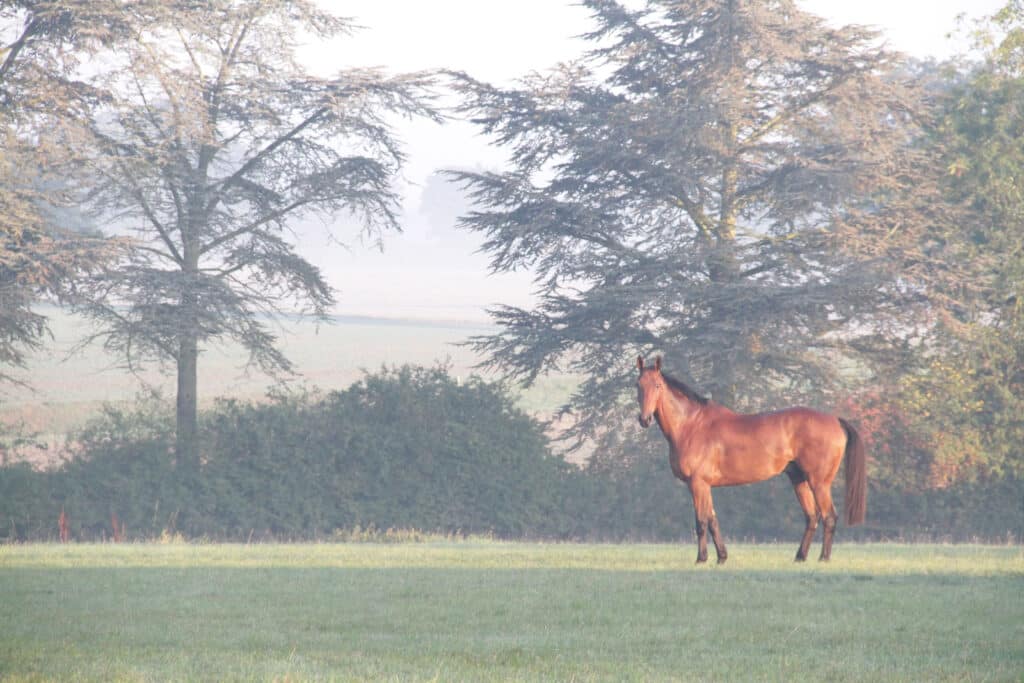Briony Witherow, takes a look at how the changing seasons affect our horses
As we move into the winter months and the evenings progressively draw in, this means a change in management for our horses. Routines adjust to accommodate the shorter days, which for some will mean limited turnout, more stabling and for many, the winter months will also bring a change in exercise regime. While hunters will see their workload increase, eventers may have some time off. Whatever the scenario, a change in management can often impact the gut, weight, and condition. In this article we will discuss key management changes and how and why they impact the gut, weight, and condition and how to adjust rations appropriately.
Digestive challenges: dealing with change
Many of the digestive challenges experienced by the horse, stem from changes in management. These are typically brought about by decreasing availability of fresh forage (grass) and subsequent increase in hay/haylage and concentrate feed or, vice versa.
The biggest factors to consider when changing from grass to hay or haylage are the moisture and fibre content1. Grass is higher in moisture and lower in fibre than hay and haylage – meaning our horses are going from comparatively easy to digest forage with lots of added moisture to help motility (gut movement), to one that is considerably drier, higher fibre and less digestible1. In the longer term, this, coupled with less movement (increased stabling, decreased exercise) can increase risk of digestive complications such as impaction colic2. In the short term, if changes to the forage ration are made too quickly, it is common to see loose manure and increased colic risk2.
So, how can we help support our horses during this period?
Plan ahead; try to make changes gradually, and one at a time. Where both the hard feed and forage ration need to be changed, change the forage first and then once settled in your new routine, adjust the hard feed.
Forage changes should be made over 2 to 4 weeks1, decreasing turnout and increasing hay/haylage gradually wherever possible. For example, offering hay/haylage in the field or bringing the horse in for a few hours a day for hay/haylage will help to provide a more gradual introduction.
For hard feed, make any changes gradually over at least 10-14 days – longer if you have a horse with a history of colic or a sensitive digestive system.
Some horses may benefit from added digestive support during management changes. Adding a prebiotic supplement to support a healthy environment in the hindgut for fibre-digesting microbes3,4 is good practice and recommended where gradual changes are not feasible or, horses have shown sensitivity management/ration changes in the past (such as loose manure, colic).
A combination of decreased intestinal motility and decreased water intak is a common scenario for many horses over the winter months, frozen water sources, dried foods, coupled with less movement5. As such, it is key, where possible to monitor and promote water intake:
- Provide clean fresh water at all times – frequently clean troughs/buckets and check for contaminants
- Learn what is normal for your horse
- Use buckets instead of automatic waterers
- Monitor your horse’s water intake over a normal week and take an average
- Ensure your horse’s diet is meeting his sodium requirements through providing a salt lick or salt in the feed.
- In cold weather add hot water to drinking water; studies have shown a preference to warm water and subsequently have a larger water intake, one study showing a preference of warm water between 20-35 degrees Celsius in comparison to near freezing water6.
- Make use of succulents and soakable feeds to boost moisture intake.
Managing the poor doer
The change in fibre source often brings with it a general drop in nutrient intake, which, coupled with a change in weather, can increase the horse’s calorie requirement and in some, result in weight loss. Knowing what is normal for your horse and being proactive about weight management is paramount when trying to avoid weight loss. For example, if you know your horse usually starts to lose weight when they start to come in overnight, proactively manage body condition score so that they have a buffer coming out of summer (6 out of 9 on a 9-point scale for example); and monitor closely, adapting the feeding regime as soon as early signs of weight loss are apparent.
Being more selective about the forage source (when practicable) may also help those that lose weight when grass is off the menu. Selecting an earlier cut hay or haylage (the latter often being more palatable and digestible)1. Where possible have forage analysed for a clearer picture of calorie intake and ultimately, more control. While there are added costs with analysis (between £20-60) and selecting a better-quality forage, it is often still more economical in the long-term than focusing on bucket feeds alone.
Making up the majority of our horses’ diets, a change in forage can make a significant difference. For example, a later cut hay might provide 8MJ/kg of digestible energy (calories), where an earlier cut hay may provide 10.5MJ/kg of digestible energy (calories). If your horse has 10kg of this hay per day, the difference between the two is 25MJ, that is the equivalent of 2kg (1 heaped Stubbs scoop) of a conditioning cube per day (~£1.50 per day or ~£275 for 6 months).
When it comes to hard feed, again, being proactive and making changes early (or in anticipation, if you know the horse well) will see most success. Remember that the digestive system needs time to adapt and start utilising new ingredients optimally7. Where high oil feeds are concerned, as the horse does not have a gall bladder, it can take up to 6 weeks for them to fully utilise a high oil ration.
Where possible start to introduce winter feeds as early as autumn to help to make sure that the gut is able to make the most of nutrients when needed. Alternatively, choosing a ration that can be fed in smaller quantities during the summer months and just be increased in the winter months, works well. For example, a balancer with Alfalfa Plus Oil and Outshine the latter two fed at just a handful in the summer and increased during the winter.
Managing the good doer
If your horse is naturally a good doer and comes out of summer carrying a little extra, we can use winter to our advantage to kick start weight loss. Horses are naturally designed to gain weight over the summer months, to then lose it again when food becomes scarce during the winter months8. Domestication and all that comes with it, including rugs, stabling, supplementary forage, and feed on tap, means horse’s often skip the weight loss and cumulatively gain weight year on year. So, as owners and carers of good doers, we need to break this cycle, and winter is the ideal opportunity.

The following tactics can be employed to maximise losses over the winter months:
- Use lower fill or no rugs and, get your clippers out to encourage your horse to burn calories to stay warm. With milder winters, many horses don’t need rugging for warmth.
- Maintain or increase exercise over the colder months.
- Aim to enter spring with a body condition score of 4 out of 9 on a 9-point scale. This will negate year-on-year weight gain and give you a buffer for inevitable spring and summer gains.
- If providing supplementary forage out in the field, keep a close eye on grass availability. With milder winters, grass can keep growing much later into the season.
- Where possible carefully consider and choose your forage. Just as we discussed with the poor doer, selecting an appropriate forage for your horse can help save both time and money. For better doers, choosing a later cut forage may mean less calories and a less restricted ration.
- Keep to the necessities when it comes to hard feed. For most good doers, this means a balancer, fortified chaff or powdered vitamin and mineral supplement. Even for good doers ensuring vitamin, mineral and quality protein content is key and (alongside exercise) helps to ensure than any loses seen are fat, not lean muscle mass. Try to avoid the temptation to provide large quantities of dried grass chaff or nuts as a ‘replacement’ for pasture. Hay is also dried grass but contains typically less calories (and sugar) and will occupy more of your horse’s time.
- Monitoring weight and condition regularly (every week during a period of change) using a weigh tape (or weighbridge) and body condition scoring (BCS) is essential in ascertaining whether your horse is gaining, losing, or maintaining weight and condition. Remember that the ‘ideal’ BCS should be specific to the individual horse. On a 9-point scale, a 5 would represent a moderate BCS and therefore, be appropriate for some horses. However, an ideal BCS for a good doer coming into spring would be 4-4.5.
- Avoid turnout when sugar levels may be at their highest – remember that when grass is higher in sugars, it is essentially higher in calories. A key scenario to avoid is frosty bright mornings during the winter months or bright days in the spring/autumn where overnight temperatures drop below 5°C 9,10.
References
- Harris, P.A., Ellis, A.D., Fradinho, M.J., Jansson, A., Julliand, V., Luthersson, N., Santos, A.S., Vervuert, I. (2017) Review: Feeding conserved forage to horses: recent advances and recommendations. Animal: An International Journal of Animal Science, 11 (6): 958-967
- Hillyer, M.H., Taylor, F.G.R., Proudman, C.J., Edwards, G.B., Smith, J.E., and French, N.P. (2002) Case control study to identify risk factors for simple colonic obstruction and distension colic in horses. Equine Veterinary Journal, 34 (5): 455-463
- Morgan, L.M., Coverdale, J.A., Froetschel, M.A. and Yoon, I. (2007) Effect of yeast culture supplementation on digestibility of varying forage quality in mature horses. Journal of Equine Veterinary Science. 27(6): 260-265.
- Jouany, J.-P., Medina, B., Bertin, G., and Julliand, V. (2009) Effect of live yeast culture supplementation on hindgut microbial communities and their polysaccharidase and glycoside hydrolase activities in horses fed a high-fiber or high-starch diet. Journal of Animal Science, 87 (9): 2844-2852.
- Williams, S., Horner, J., Orton, E., Green, M., McMullen, S., Mobasheri, A., & Freeman, S. L. (2015) Water intake, faecal output and intestinal motility in horses moved from pasture to a stabled management regime with controlled exercise. Equine Veterinary Journal, 47(1): 96–100.
- Kristula, M.A., and McDonnell, S.M. (1994) Drinking water temperature affects consumption of water during cold weather in ponies, Applied Animal Behaviour Science, 41:155-160
- NRC, (2007) Nutrient requirements of Horses, Sixth edition. National Academies Press: Washington, DC.
- Dugdale, A.H., Curtis, G., Cripps, P.J., Harris, P.A., and Argo, C.M. (2010) Effects of season and body condition on appetite, body mass and body composition in ad libitum fed pony mares. Veterinary Journal, 42 (7): 600-610
- Watts KA (2004) Forage and pasture management for laminitic horses. Clinical techniques in equine practice 3 (1): 88-95
- Watts KA (2010) Pasture management to minimise the risk of equine laminitis. Veterinary clinics of North America, 26 (2): 361-369

